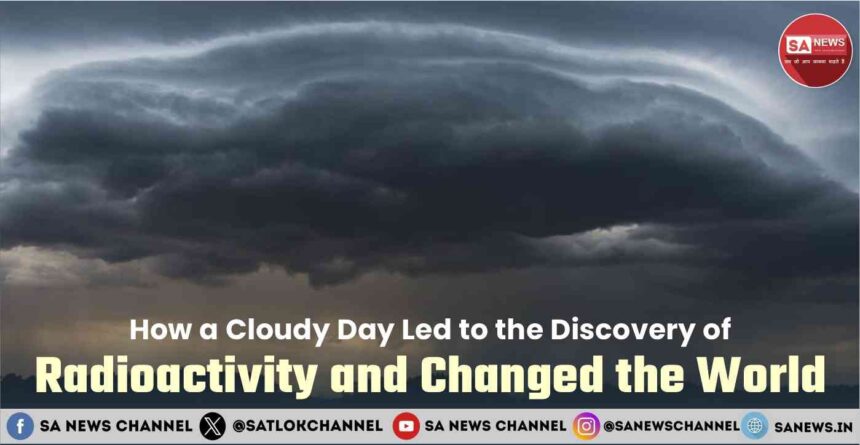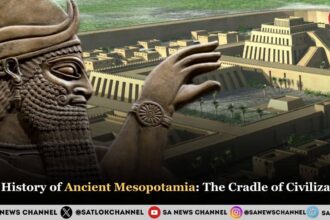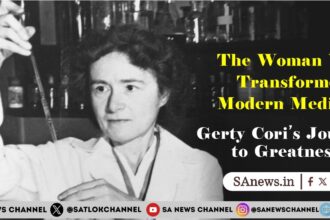In the annals of scientific history, few discoveries have emerged so unexpectedly and with such profound consequences as that of radioactivity. It was not the prize at the end of a deliberate quest but a mystery stumbled upon in a dark drawer. This single, serendipitous finding didn’t just add a new chapter to physics; it tore up the old book entirely.
- A World on the Brink of Revolution: The Scientific Climate of the Late 19th Century
- The Serendipitous Discovery: Henri Becquerel and the Cloudy Days of 1896
- From a Curious Ray to a New Science: Marie and Pierre Curie
- The Shattering of Certainty: How Radioactivity Redefined Physics
- Unleashing the Atom: Energy, Weapons, and the Nuclear Age
- The Healing Ray: A Revolution in Medicine
- The Unseen Dangers and Ethical Burdens
- The Unseen Architect Behind Scientific Breakthroughs
- From a Fogged Plate to a Changed World
- FAQs
The story of radioactivity is a compelling narrative of curiosity, accident, and genius, which ultimately unlocked the power of the atom, giving humanity the means to both heal and destroy on an unimaginable scale. From a fogged photographic plate in 1896 to the nuclear power plants and medical therapies of today, this is the journey of a discovery that continues to shape our world.
A World on the Brink of Revolution: The Scientific Climate of the Late 19th Century
To appreciate the shockwave of radioactivity, we must first understand the world it entered. The late 1890s were a time of supreme confidence in classical physics. The elegant laws of Newtonian mechanics governed the heavens and the earth, while the atom was widely considered the fundamental, indivisible, and eternal building block of matter, a tiny, solid sphere, unchanged and unchangeable. Science, it seemed, was mostly a matter of refining existing knowledge.
Yet, subtle cracks were beginning to appear in this pristine facade. In late 1895, this confidence was shaken by a discovery made purely by accident. The German physicist Wilhelm Röntgen was experimenting with a cathode-ray tube in his darkened laboratory. Having completely covered the tube in black cardboard to block all visible light, he was startled to see a nearby screen coated in a fluorescent chemical begin to glow. He deduced that some new, unknown ray powerful enough to escape the shielded tube and penetrate the air was responsible. He famously called them “X-rays,” with ‘X’ signifying their mysterious nature.
The discovery proved that there were forms of radiation more mysterious and penetrating than visible light, and it ignited a fever of excitement across scientific laboratories. Researchers everywhere were eager to explore this new frontier of invisible rays, and among them was a French physicist named Henri Becquerel, whose own investigations would soon lead him down an entirely different and far more revolutionary path.
Even before this, there were unheeded whispers of the atom’s hidden nature. For decades, chemists and miners had known of the peculiar properties of uranium salts. These compounds had a strange habit of fogging photographic plates stored nearby, but the phenomenon was consistently dismissed as a chemical anomaly, a faulty seal, or simple contamination – a minor nuisance rather than a clue to a cosmic secret.
The Serendipitous Discovery: Henri Becquerel and the Cloudy Days of 1896
Henri Becquerel was fascinated by the link between light and energy. Following Röntgen’s discovery, he formulated a hypothesis: could it be that phosphorescent materials, which glow after being exposed to light, also emit these powerful X-rays? His logic was plausible. He theorized that the sun’s energy was absorbed by these materials and then re-emitted as a more penetrating form of radiation. His material of choice was a sample of uranium potassium sulfate, a known phosphorescent salt.
The Intended Experiment
Becquerel’s experimental design was simple and elegant. He would wrap a photographic plate in thick black paper, making it impervious to sunlight. Then, he would place the uranium crystals on top of the wrapped plate and leave the entire setup in the bright Parisian sun. If his hypothesis was correct, the sunlight would energize the crystals, causing them to emit X-rays that would penetrate the paper and expose the plate, creating an image of the crystals. His initial experiments were a success; when developed, the plates showed a clear silhouette, seemingly confirming his theory.
An Unplanned Delay and a Fortunate Twist
In late February 1896, Becquerel prepared another iteration of his experiment. However, the skies over Paris turned grey and overcast, denying him the strong sunlight he needed. Frustrated but undeterred, he placed the entire apparatus, the uranium salts still resting on the carefully wrapped photographic plate, into a dark desk drawer to await a sunnier day.
Also Read: Turning Pain into Powerful Art: Frida Kahlo Biography
The clouds lingered. For several days, the experiment lay dormant in complete darkness. On March 1st, for reasons that remain a subject of historical speculation, perhaps sheer impatience or a scientific hunch, Becquerel decided to develop the plate anyway. By all conventional logic, he should have found a blank or, at most, a very faint image from any residual phosphorescence.
The Moment of Revelation
What he saw instead was astonishing. The photographic plate was not faintly marked but intensely fogged. The image of the uranium crystals was as sharp and clear as if it had been exposed to brilliant sunlight for hours. The conclusion was inescapable and paradigm-shattering: the sun had nothing to do with it. The uranium salts were emitting powerful, penetrating radiation entirely on their own, without any external source of energy.
This was not phosphorescence, nor was it X-rays as he understood them. It was a new, intrinsic property of the uranium atoms themselves. They were spontaneously radiating energy. In that moment, Henri Becquerel had accidentally discovered radioactivity and, with it, the key to unlocking the atom.
From a Curious Ray to a New Science: Marie and Pierre Curie
Becquerel had opened the door, but it would be a brilliant young Polish scientist, Marie Skłodowska-Curie, and her husband, Pierre Curie, who would walk through it and explore the vast new world beyond. Choosing Becquerel’s mysterious “uranic rays” as the subject for her doctoral dissertation, Marie Curie began a systematic investigation that would transform physics and chemistry.
Coining “Radioactivity” and Measuring the Invisible
Using a sensitive electrometer developed by Pierre and Jacques Curie, Marie Curie began to meticulously measure the intensity of the radiation from various uranium compounds. She quickly confirmed Becquerel’s finding: the intensity of the radiation depended only on the amount of uranium present, not on its chemical form or any external factors like temperature or pressure.
This led her to a monumental insight: the radiation was not a result of a chemical reaction between molecules but a fundamental property of the atom itself. It was an atomic phenomenon. She proposed the name “radioactivity” to describe this spontaneous emission of rays.
The Hunt for New Elements
Her measurements revealed another anomaly. Certain uranium ores, like pitchblende, were significantly more radioactive than could be explained by their uranium content alone. She hypothesized that these ores must contain small quantities of another, far more radioactive, undiscovered element.
What followed was a heroic feat of scientific labor. Marie and Pierre Curie obtained tons of pitchblende ore and, working in a drafty, shed-like laboratory, began the arduous process of chemical separation. In 1898, their grueling work paid off. They announced the discovery of not one, but two new radioactive elements. The first they named Polonium, in honor of Marie’s native Poland. The second, a substance millions of times more radioactive than uranium, they named Radium, for its intense radioactivity. The isolation of radium provided undeniable proof that elements could be unstable, fundamentally changing our understanding of matter.
The Shattering of Certainty: How Radioactivity Redefined Physics
The work of Becquerel and the Curies sent a shockwave through the scientific community. The discovery that atoms could spontaneously disintegrate and emit energy invalidated the centuries-old belief that atoms were solid, eternal, and indivisible. Matter was not static; it was dynamic and, in some cases, unstable.
This revelation was the starting point for modern physics. It led directly to Ernest Rutherford’s groundbreaking experiments, which used radioactive particles as projectiles to probe the atom’s structure. His discovery of the atomic nucleus in 1911 would have been impossible without it. The study of alpha, beta, and gamma radiation, the different types of radioactive emissions, paved the way for a deeper understanding of subatomic particles and the forces that bind them, ultimately leading to the development of nuclear physics and quantum mechanics.
Unleashing the Atom: Energy, Weapons, and the Nuclear Age
The energy released by radioactivity was immense, a fact explained in 1905 by Albert Einstein’s famous equation, E = mc^2, which demonstrated that a tiny amount of mass could be converted into a vast quantity of energy. For decades, this remained a theoretical curiosity until 1938, when Lise Meitner and Otto Hahn discovered nuclear fission, the process of splitting a heavy atomic nucleus, like that of uranium, to release a torrent of energy.
This discovery occurred on the eve of World War II, and its military implications were immediately apparent. The urgency of the war led to the Manhattan Project, a top-secret US initiative to build an atomic weapon. In August 1945, the world witnessed the terrifying power of this new science with the bombing of Hiroshima and Nagasaki. The nuclear age had begun, forever changing geopolitics and introducing the existential threat of atomic warfare.
In the post-war era, efforts turned to harnessing this power for peaceful purposes. “Atoms for Peace” became a mantra, leading to the development of nuclear power. The first commercial nuclear power plant came online in the 1950s, promising a future of clean, abundant electricity. However, this promise was tempered by ongoing debates about the safe disposal of radioactive waste and the potential for catastrophic accidents.
The Healing Ray: A Revolution in Medicine
While one side of radioactivity’s legacy was tied to destruction, the other was dedicated to healing. Almost immediately after its discovery, physicians began to explore the use of radium to treat cancer. This marked the birth of radiotherapy, a cornerstone of modern oncology, where targeted radiation is used to destroy malignant cells.
This grew into the broader field of nuclear medicine. Radioactive isotopes are now indispensable diagnostic tools. When introduced into the body, these “tracers” allow doctors to map biological processes and visualize organs with incredible detail using techniques like Positron Emission Tomography (PET) scans. Furthermore, gamma radiation is widely used to sterilize medical equipment, ensuring patient safety in hospitals worldwide.
The Unseen Dangers and Ethical Burdens
The pioneers of radioactivity paid a heavy price for their discoveries. Unaware of the profound dangers of sustained exposure, many early researchers handled radioactive materials with little to no protection. Marie Curie herself died in 1934 from aplastic anemia, a bone marrow disease almost certainly caused by her years of work with radium. Her notebooks are still so radioactive today that they must be stored in lead-lined boxes.
The true scale of radiation’s dangers became tragically clear to the public with nuclear accidents like Chernobyl in 1986 and Fukushima in 2011. These disasters released massive amounts of radioactive material into the environment, causing long-term health consequences, including cancer and genetic damage, and rendering vast areas of land uninhabitable for generations.
These events forced a reckoning within the scientific community and society at large. The discovery of radioactivity marked a turning point where science could no longer be viewed as a purely objective quest for knowledge. It now carried a profound ethical burden, as the same principles that could cure cancer could also be used to create weapons of mass destruction.
The Unseen Architect Behind Scientific Breakthroughs
Henri Becquerel’s accidental discovery of radioactivity offers another profound parallel to a core tenet within the Sat Gyaan (True Knowledge) imparted by Sant Rampal Ji Maharaj. Becquerel’s original experiment, thwarted by cloudy weather, led him to store uranium salts on a photographic plate in a dark drawer. His inexplicable urge to develop that plate, which defied his scientific hypothesis, revealed the invisible rays of radioactivity.
This mirrors the principle that while all events are orchestrated by divine will, the Supreme God allows His devotees, and even humanity at large, to receive the credit and honor for such breakthroughs.
As described in holy scriptures, Brahm (Kaal) has entered the bodies of righteous individuals to grant them power, and the Bhagavad Gita speaks of God as the unseen strength within every being. However, accessing this power through traditional means has always demanded immense payment requiring grueling austerities (tapasya), complex rituals, and relentless efforts that take a heavy toll on the practitioner.
In stark contrast, Sant Rampal Ji Maharaj teaches that true worship (Satbhakti), as prescribed in the holy Vedas and obtained via initiation from a Tatvadarshi Guru (True Spiritual Teacher), provides a direct path to divine grace without such burdens. This authentic worship does not drain the devotee; rather, it empowers them effortlessly. Instead of paying a heavy price through physical hardship, a devotee’s mind is naturally illuminated with insights, leading to great discoveries or spiritual advancement toward moksha (liberation).
Thus, while Henri Becquerel was celebrated for his revolutionary finding, this spiritual perspective sees the unseen hand of God orchestrating the circumstances, allowing a prepared mind to perceive a hidden truth, and ultimately letting the human observer receive worldly acclaim.
From a Fogged Plate to a Changed World
From a simple fogged image on a photographic plate, born from a frustrated experiment on a cloudy day, emerged a force that would redefine humanity’s future. The discovery of radioactivity unlocked the atom, unleashing a dual legacy of immense power. It gifted us the ability to cure diseases with radiotherapy and explore the cosmos, yet it also handed us the terrifying might of nuclear weapons and the haunting memory of Chernobyl.
Whether viewed as a remarkable scientific accident or a moment of divinely guided insight, the event demonstrates how a single, unexpected observation can reshape our world. It underscores that discovery is not just about finding answers, but also about being prepared to see the extraordinary in the mundane. Over a century later, the invisible rays from that drawer continue to illuminate our path, serving as a potent reminder of the profound and often unpredictable relationship between chance, curiosity, and human destiny.
FAQs
1) When was radiation first discovered?
Ans. Spontaneous radiation (radioactivity) was first discovered in 1896 by Henri Becquerel. This is distinct from the discovery of X-rays in 1895.
2) What is radiation and who discovered it?
Ans. Radiation is energy that travels as waves or high-energy particles. While many people contributed to understanding different types of radiation, French physicist Henri Becquerel is credited with discovering radioactivity in 1896.
3) Who is the father of radiation?
Ans. Henri Becquerel is widely considered the “father of radiation” for his foundational discovery of spontaneous radioactivity.
4) Who discovered radiation in 1895?
Ans. In 1895, German physicist Wilhelm Röntgen discovered X-rays, a form of radiation. The discovery of radioactivity was made the following year by Henri Becquerel.
5) Which element did Marie Curie discover first?
Ans. The first element Marie Curie co-discovered was Polonium in 1898, which she named after her home country, Poland.









